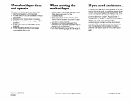
For use where
local codes
permit use of
flexible power
supply cord.
four-wire
three-wire
receptacle(l4-30R) receptacle(lO-30R)
Figure 3
Figure 4
Four-wire insfallufion is recommended
(required for mobile homes): The power
supply cord must have four, No.-1 0
copper wires and match a four-wire
receptacle of NEMA Type 14-30R (see
Figure 3). The fourth wire (grounding
conductor) must be identified with a
green cover and the neutral conductor
by a white cover.
Three-wire installation (if a four-wire
system is not available): The power
supply cord must have three, No.-1 0
copper wires to match a three-wire
receptacle of NEMA Type 1 O-30R (see
Figure 4).
Where local codes permit
connecting cabinet-
conductor to the 3
rounding
neu ral wire:
center silver-colored
terminal block screw
\Vf I ,appliance
harness
grounding wire
center silver-colored
appliance harness
terminal block screw
\
Figure 5
1. Disconnect the power supply.
2. Remove terminal block cover.
3. Install copper, four-wire power
supply cord through strain relief.
4. Remove the appliance harness
grounding wire (green with yellow
stripes) from the internal grounding
connector and fasten under
center, silver-colored terminal block
screw.
5. Connect the grounding wire
(green) of the copper, four-wire
power supply cord to the internal
grounding connector.
6. Connect the neutral wire (white) of
the power supply cord to the
center, silver-colored terminal screw
of the terminal block. Connect the
other wires to the outer terminals.
Tighten screws firmly.
7. Tighten strain relief screws.
8. Replace the terminal block cover.
$$ 1. Disconnect the power supply.
$$ 2. Remove terminal block cover.
$3; 3. Strip 5 inches of outer covering from
:::::::::::
:::::::::::
.:::p,:::
end of cable. Leave bare
:::::::::::
:::::::::::
:::::::::::
grounding wire at 5 inches. Cut
;i;i;;i;;$
:~~~~~~::‘:
1-l /2 inches from 3 remaining
,:.:.:.:.:.
:::::::+
insulated wires. Strip insulation back
:.:p-:.,
ig:i:s.::
1 inch (see Figure 6).
i . . . . .
3/4” U.L.-listed
strain relief,
J
.-.-.
. . . . .
. . . . .
,:,:.:
:.:,>
. . . . .
,:,:,:
:;::)
22.
4
1. Disconnect the power supply.
2. Remove terminal block cover.
3. Install copper three-wire power
supply cord through strain relief.
4. Connect the neutral wire (white or
center) of the power supply cord to
the center, silver-colored terminal
screw of the terminal block.
Connect the other wires to the
outer terminals. Tighten screws
firmly.
5. Tighten strain relief screws.
6. Replace the terminal block cover.
Direct wire
The washer/dryer can be connected
directly to fused disconnect or circuit
breaker box with four-wire or three-wire
flexible armored or non-metallic
sheathed copper cable (with grounding
wire). Do Not use two-wire with bare
grounding wire. All current-carrying
wires must be insulated.
A conduit connector must be installed
at junction box. USE ONLY lo-GAUGE
SOLID COPPER WIRE. DO NOT USE
ALUMINUM WIRE. Allow four feet of slack
in the line so dryer can be moved if
servicing is ever necessary.
Where local codes permit
connecting cabinet-
3
rounding
conductor to the neu ral wire of the
power supply cable:
Electrical connection
. . .-.-.-.-:.-.
..-.-.-.-.-...~
$$$$j~ 1. Disconnect the power supply.
! A’
m
*
-
Electrical Shock Hazard
Check that wiring you are using
matches colors shown in illustrations
and specified in instruction steps. If
wiring does Not match, it is your
responsibility to have a qualified
electrician install the correct wiring.
Failure to install the correct wiring
could result in death or serious injury.
;:j:j:j:j:j:j:j:
.:,:.:.:,:,:,>:
:;::::::x:::::
/I
Electrical Shock Hazard
::::::::::::::::
f$J$$ Do Not use two-wire with a bare
:::::<:::ij
.-::..:. _.:
:::;:::;g::
::::::::::::::::
:;:;:::;:;:g;:;
grounding wire. All current-carrying
wires must be insulated.
wires
. . ..--
stritmed of
insihtion
:::::::<:::;:~I.
:zz$ Failure to install the correct wiring
@ could result in death or serious injury.
:::::::::::::::,
ig;;;iijijig
~iiltiii;:: 2. Remove terminal block cover.
$$$$
3.
Strip 3-l /2 inches of outer covering
:::::;:::::::::
from end of cable. If using three-
::::::::::::::::
:;:i:;:;:;:;:;:i
::::::::::::::::
wire cable with grounding wire, cut
::::::::::::::::
::::::::::::::::
the bare wire even with outer
::::::::::::::::
::::::::::::::::
~:::~:~~~:~~:~:’
covering. Strip 1 inch of insulation
::::::::::::>>
::::::::y$:
.A.. ..,_,.,,,.
from the end of each insulated wire
This washer/dryer Is manufactured wlth the
neutral termlnal connected to the cabinet.
Direct wire preparation
\1
Figure 6
u-shaped
Shape the end of
hook
each wire into a ‘U”
shaped hook (see
Figure 7). The bare
grounding wire must
be 4-l /2” long after
Figure 7
forming the hook.
4. Install copper, four-wire power
supply cable through strain relief.
5. Remove the appliance harness
grounding wire (green with yellow
stripes) from the internal grounding
connector and fasten under center,
silver-colored terminal block screw.
6. Slide the hook end of the grounding
wire (bare) of the four-wire power
supply cable under the internal
grounding connector screw.
Squeeze hook end of wire together.
Tighten screw.
7. Connect the neutral wire (white) of
the power supply cable to the
center, silver-colored terminal screw
of the terminal block using the same
method. Connect the other wires to
the outer terminals. Tighten screws
firmly.
8. Tighten strain relief screws.
9. Replace the terminal block cover.
(see Figure
9).
Bare wire cut short. Wire is not
314” U.L.-listed
strain relief ,
used. Dryer is grounded
through direct wire cable.
I
_ I
Direct wire preparation
Figure 9
;J$;Ped Shape the end of
each wire into a
‘U” shaped hook
(see Figure 10).
Figure 10
Panel B











